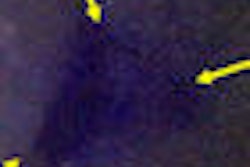When used together, optical coherence tomography (OCT) and polarimetry offer a power diagnostic tool for the dysplasia that typically precedes squamous cell carcinoma of the oral cavity, according to a study in the Journal of Biomedical Optics (July 6, 2011).
A noninvasive diagnostic modality would enable monitoring of dysplastic lesions at regular intervals and enhance detection at a very early, relatively harmless stage, according to the study authors from Pukyong National University, Pusan National University, and the University of California at Irvine.
They used OCT and polarimetry to conduct noninvasive diagnosis of oral premalignancy and malignancy using the hamster cheek pouch model (nine hamsters). The results were compared with tissue histopathology.
"During carcinogenesis, epithelial down grow, eventual loss of basement membrane integrity, and subepithelial invasion were clearly visible with OCT," the researchers wrote.
In addition, polarimetry identified a four to five times increased retardance in sites with squamous cell carcinoma and two to three times greater retardance in dysplastic sites than in normal tissues.
"These techniques were particularly useful for mapping areas of field cancerization with multiple lesions, as well as lesion margins," the authors concluded.



















